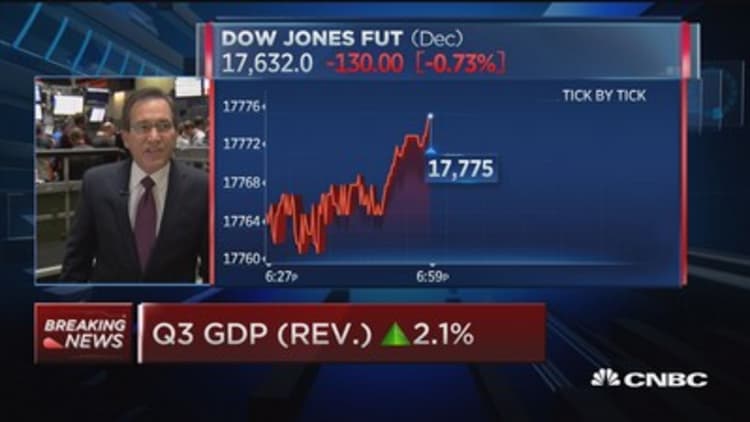
The U.S. economy grew at a healthier clip in the third quarter than initially thought, suggesting resilience that could help give the Federal Reserve confidence to raise interest rates next month.
The Commerce Department on Tuesday said the nation's gross domestic product grew at a 2.1 percent annual pace, not the 1.5 percent rate it reported last month. It said efforts by businesses to reduce an inventory bloat had not been as aggressive as previously believed.
The growth estimate was also boosted by upward revisions to business spending on equipment and investment in home building. While consumer spending was revised down a bit, its pace remained brisk.
When measured from the income side, the economy grew at a brisk 3.1 percent clip, an acceleration from the second quarter's 2.2 percent pace.
The third-quarter's respectable expansion should set up the economy to achieve at least 2 percent growth in the second half of the year, around its long-run potential. In the wake of robust job growth in October and strong domestic demand, the Fed is expected to raise rates at its Dec. 15-16 policy meeting.
The GDP revision was in line with economists' expectations. Businesses accumulated $90.2 billion worth of inventory in the third quarter, instead of the $56.8 billion reported last month.
Read More If the Fed hikes, who in the world will follow?
As a result, the change in inventories chopped off 0.59 percentage point from third-quarter GDP growth, rather than the 1.44 percentage points the government reported in October.
That, however, suggests inventories could be a drag on fourth-quarter growth.
Consumer spending, which accounts for more than two-thirds of U.S. economic activity, grew at a 3.0 percent rate, down from the 3.2 percent rate estimated last month. The downward revisions mostly reflected weak outlays on communication services and utilities.
A measure of private domestic demand, which excludes trade, inventories and government spending, was revised down to a still sturdy 3.1 percent pace from the previously 3.2 percent rate.
Read MoreExpect at LEAST three rate hikes in 2016: Economist
Though there are signs consumer spending slowed early in the fourth quarter, it is likely to remain supported by a tightening labor market, rising house prices, which are boosting household wealth, as well as low inflation.
Growth in exports, which have been hurt by a strong dollar and sluggish global demand, were revised to show a slower 0.9 rate of increase. With imports rising at a slightly faster pace than previously reported, that left a trade deficit that subtracted 0.22 percentage point from GDP growth.
Trade was previously reported to have had a neutral impact on GDP growth.
Deep spending cuts by energy firms following a collapse in oil prices continued to weigh on growth. Spending on mining exploration, wells and shafts tumbled at a 47.1 percent rate, rather than the 46.9 percent pace reported last month.
Read MoreCiti's Buiter: Fed will never reach normal
Investment in nonresidential structures contracted at a 7.1 percent pace, instead of the previously reported 4.0 percent rate. However, business spending on equipment was revised up to a 9.5 percent rate from a 5.3 percent pace.
The Commerce Department also reported that corporate profits after tax fell at a 1.6 percent rate in the third quarter after rising at a 2.6 percent pace in the second quarter. Profits, which have been undercut by the dollar's strength and lower oil prices, were down 8.1 percent from a year ago, the biggest decline since the fourth quarter of 2008.

